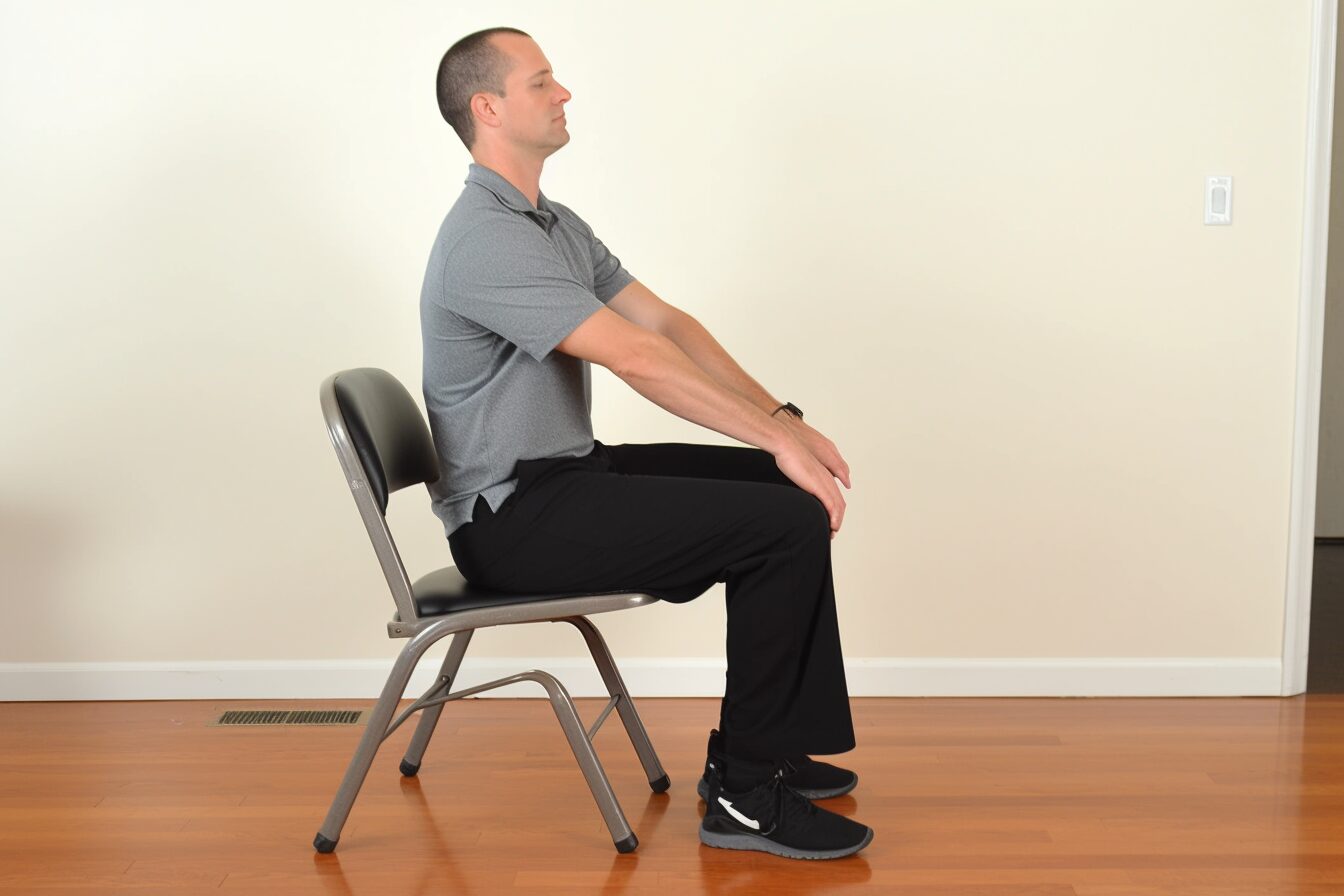Easy Back Alignment Exercises for a Healthier Spine
Let's dive straight into the world of back alignment exercises. These aren't just any routines; they're your ticket to a life with less back pain and more vitality. Hang in there, and you'll discover how aligning your spine correctly can significantly boost your overall health and happiness. We're talking about reducing those nagging pains that creep up after a long day at work or during an intense workout session.
You don’t need fancy equipment or a gym membership to get started. From the comfort of your home, we’ll guide you through simple yet effective exercises designed to strengthen your core, enhance shoulder mobility, and maintain good posture—essential components for keeping your spine happy.
Embarking on this path transcends mere physical contortions; it's a holistic shift in your daily locomotion. Ready? Let’s make every step count towards building a healthier spine.
Table Of Contents:
- Understanding Spine Alignment and Its Impact on Health
- The Consequences of a Misaligned Spine
- Exercises for Spine Alignment at the Gym
- Home Exercises to Maintain Spinal Health
- Shoulder Mobility's Role in Spine Health
- The Importance of Neutral Spine Position
- The Significance of Proper Body Mechanics
- Tactics for Enhancing Your Spinal Alignment
- FAQs in Relation to Back Alignment Exercises
- Conclusion
Understanding Spine Alignment and Its Impact on Health

Our spine isn't merely a collection of bones; it's the core pillar supporting our health. It's the backbone of our health, quite literally. An aligned spine not only upholds our health by opposing gravity's pull but also enhances the smooth operation of our joints.
Natural curves of the spine
Spines are like nature’s shock absorbers, enhancing joint efficiency by distributing weight evenly throughout the body. The significance of this alignment cannot be overstated, as overemphasized curves might result in various ailments ranging from migraines and neck strain to sciatica torment in the limbs or discomfort around the hips and knees.
Importance of Core Exercises
To maintain this balance between strength and flexibility around these natural curves, engaging in specific exercises aimed at strengthening core muscles becomes essential. Not only does it improve posture but also ensures that each segment of your back works harmoniously with each other for optimal health.

Subscribe To Dr Mike's MVP Newsletter!
Exclusive content, interesting topics, real insights.

The Consequences of a Misaligned Spine
Imagine your spine as the main highway for all nerve communications in your body. Now, think about what happens when there's a traffic jam due to road misalignment—everything slows down or stops working correctly. That’s pretty much what occurs with a misaligned spine.
Adopting a slouched stance and allowing the spine to deviate from its natural alignment not only invites minor aches but also paves the way for more grave health complications. When the natural curves of our spine become exaggerated, we’re talking headaches that make you want to live in a dark room forever, neck and shoulder pain that makes turning your head feel like an Olympic sport, sciatica screaming down your leg, not to mention hip and knee pains making stairs look like Mount Everest.
These physical issues from poor posture aren’t trivial by any means. Research indicates that maintaining the natural alignment of our spine is essential to prevent a range of discomforts. But how do you know if your spine is out of whack? Some telltale signs include uneven shoulders or hips and chronic pain in areas affected by spinal nerves—which basically could be anywhere from your eyes down to your toes.
Maintaining good alignment ensures every part of the body works harmoniously together. So whether it's sitting at a desk all day or carrying groceries home, paying attention to how we move through space can prevent these cascade effects triggered by misalignments—from minor annoyances right up to debilitating conditions that can seriously cramp our style (and well-being).
Exercises for Spine Alignment at the Gym
Core Strengthening Moves
Gym exercises tailored for spine alignment primarily focus on beefing up your core, as a strong core is crucial for maintaining good posture and spinal health. Lifting weights does more than just sculpt your appearance; it's key in refining how your body operates, enabling you to maintain an upright and assured stance.
By weaving gym tools into your workout regime, you'll markedly amplify the vigor of your strength conditioning program. For women especially, targeted strength training exercises not only improve posture but also form the backbone of effective weight management strategies. Remember, when we talk about strengthening the core, we're aiming to provide comprehensive support to our spine—making every movement more efficient and less prone to injury.
To get started on this journey towards optimal spinal health, consider engaging in specific workouts that challenge your abdominal muscles, back muscles, shoulder mobility, and overall upper body strength. A great exercise to include is the supine arm lengthener which works wonders by extending those often-neglected upper arms while lying face down—an ideal starting position for anyone keen on maintaining neutral spine alignment during their workout sessions.
Maintaining a neutral spine throughout these exercises ensures that each movement contributes positively towards achieving proper alignment of your natural curves—a key aspect of avoiding unnecessary stress on joint structures. So next time you hit the gym, take advantage of equipment like stability balls or resistance bands to add variety to your routine while keeping focused on that all-important goal: improving spinal alignment through strengthening those central muscles.
Home Exercises to Maintain Spinal Health

You'd be surprised how much your spine's health impacts your overall happiness, and the good news is that you don't require elaborate gear to manage its condition. Simple exercises at home can make a big difference. Here's how.
Stretching for Flexibility
Daily stretches are your best friend when it comes to spinal health. Pulling one knee towards your chest not only eases spinal tension but also enhances the suppleness of your hip flexors. Just lie on your back with knees bent and feet flat on an exercise mat, gently press one knee towards the chest, hold, then switch legs.
The chin-to-chest stretch does wonders for neck tension relief. Sitting tall or standing, simply lower your chin towards your chest until you feel a gentle stretch along the back of your neck and upper spine—perfect after long hours at the desk.
Incorporating these simple yet effective stretches into an exercise plan not only improves posture but also ensures that neutral pelvis position we all hear about from healthcare professionals.
Finding time each day for these activities could significantly improve posture over time without stepping foot outside.
You see? Keeping up with good body mechanics isn't just about lifting weights correctly; it's also about daily habits like stretching right there in our living rooms.
Luckily, aligning those vertebrae doesn't have to be complicated—simple exercises like these prove that sometimes less really is more when maintaining spinal health.
Shoulder Mobility's Role in Spine Health
When it comes to maintaining a healthy spinal alignment, the role of shoulder mobility cannot be overstated. It's not just about being able to reach for that top shelf without wincing; it’s about anchoring your shoulder blades properly to support your spine.
Stabilizing your shoulder blades forms a firm foundation for the movements of your neck and head, vital since off-kilter shoulders may swiftly cause spinal complications. Think of your spine like a well-oiled machine—every part needs to work harmoniously, or you'll end up with some unwanted squeaks and creaks.
The Consequences of Poor Shoulder Mobility
Poor shoulder mobility doesn't only affect athletes or those who engage in physical labor. Nowadays, a lot of us are glued to our screens, which often results in our chest muscles becoming tight and the muscles in our upper back getting weaker. This imbalance pulls the shoulders forward out of their natural position—a prime example of poor posture affecting overall health.
This forward pull can exaggerate the natural curves of the spine, potentially causing headaches, neck pain, sciatica problems as well as hip and knee discomfort. Engaging in exercises aimed at enhancing the flexibility of your shoulders, specifically crafted for bolstering spinal health, is a crucial move to mitigate these adverse impacts before they morph into persistent ailments.
Simple Exercises You Can Do Anywhere
routine can significantly improve your posture by opening up tight chest muscles while strengthening those around the upper back area thus promoting better alignment between shoulders and spine.
Remember: Maintaining good posture isn’t just about standing tall; it involves ensuring each part of your body from feet flat on the ground all the way up maintains its proper alignment, especially during movement. To truly benefit from these practices, ensure consistency. Find time every day, even if only a few minutes, to get moving, breathe deeply, and let go of the tension trapped within. Your future self will thank you immensely for this commitment to a healthier, more resilient body.
Key Takeaway:
Boost your spine health by improving shoulder mobility with simple daily exercises. This not only fixes posture but also prevents chronic pain, making every movement smoother and stronger.
The Importance of Neutral Spine Position

Maintaining a neutral spine position is akin to finding the sweet spot in body mechanics. It's where your pelvis, rib cage, and skull align perfectly atop each other, like meticulously stacked cups. This alignment lets you move efficiently while reducing stress on your spine.
Aligning the pelvis correctly isn't just about standing up straight; it's the foundation for everything from lifting heavy objects to simply sitting at your desk. A misalignment here can ripple out, affecting various parts of your body and leading to discomfort or even chronic pain over time.
Mastering this equilibrium demands not only instinct but also a conscious effort and repetition. For example, routines that focus on keeping your spine straight while you move can strengthen the way you hold yourself upright. These range from simple adjustments in how we sit and stand to targeted exercise routines designed specifically for spinal health.
Exercises for Maintaining Neutral Spine Position
Finding exercises that support a healthy spine doesn’t have to be complicated or require expensive equipment. In fact, some of the most effective exercises can be done right at home with little more than an exercise mat.
Gentle stretches that elongate the back muscles play a crucial role in achieving and maintaining optimal spinal alignment and ensure engagement across core musculature—a key component in supporting our backs throughout daily activities.
Incorporating strength training into your routine not only builds muscle but also helps reduce pressure on the lower back by improving overall posture and stability—essential elements when striving towards maintaining good posture both during physical activity and rest periods alike. Engaging regularly with these types of exercises improves one’s ability to maintain neutral spine positions naturally over time—a testament to their effectiveness in fostering long-term spinal health.
Key Takeaway:
Maintaining a neutral spine position is crucial for efficient movement and reducing stress on your back. Simple home exercises, like gentle stretches and strength training, can help you achieve this alignment, improving posture and preventing discomfort.
The Significance of Proper Body Mechanics
Understanding and applying the right body mechanics is like finding the secret sauce to preventing back pain. It's all about ensuring your spine doesn't scream for help after a day of work or during a gym session.
Keeping your posture upright is more than just looking confident; it plays a pivotal role in alleviating spinal tension. Whether you're lifting heavy boxes, sitting at your desk, or carrying groceries, how you move matters. The way you align your body can either be a recipe for relief or discomfort.
But what does proper alignment look like? Imagine stacking blocks perfectly one atop another - that's how our bones should align to support movement efficiently without strain. When we twist, bend incorrectly, or slouch, we throw off this balance leading to potential pain and injury.
Right Body Mechanics: A Game Changer
Embark on enhancing your posture through these targeted workouts aimed at bolstering spinal well-being. They are not just any exercises but those focusing specifically on strengthening core muscles which play a pivotal role in supporting our spine.
A strong core equals a happy back. It’s not merely about having abs but ensuring that the entire trunk of your body works harmoniously to maintain neutral spine alignment even when life tries to bend us out of shape literally and figuratively.
Last but not least, remember to always listen to what feels right for your body. Paying attention now can save lots of groans and moans down the road because let's face it – nobody has time for unnecessary back pain cramping their style.
Tactics for Enhancing Your Spinal Alignment
Good posture isn't just about looking confident. A solid foundation for your spine and general health starts with good posture, which is more than just a way to appear assured. With our eyes glued to screens and more time spent sitting, maintaining good posture has never been more crucial.
Improving spinal alignment can feel like decoding an ancient language but fear not. There are simple yet effective strategies you can adopt right now. These tactics go beyond quick fixes, aiming for lasting change that supports your spine's natural curves, reduces pressure on your joints, and keeps those nagging pains at bay.
Exercises for Spine Alignment at the Gym
If hitting the gym is part of your routine or you're considering it, incorporating specific exercises designed to strengthen core musculature can be a game-changer. Strength training doesn’t just buff up your muscles; it ensures proper form during workouts and everyday activities alike. From carrying groceries to squatting down to pick something up—strong core muscles help maintain neutral spine alignment.
Focusing on exercises that engage the abdominal muscles, back muscles, and shoulders will improve posture by reinforcing body mechanics essential for reducing stress on the spine.
Home Exercises to Maintain Spinal Health
You don't need fancy equipment or a gym membership to keep your spine happy. Engaging in straightforward activities at home, such as pulling your chin down to your chest or drawing your knees up close, can notably amplify the limberness surrounding essential structures that bolster spinal wellness. An exercise mat becomes your best friend as you work through movements aimed at lengthening the spine from neck press downs in lying positions with knees bent—a great exercise choice if pain reduction is what you’re after—to supine arm lengtheners focusing on shoulder mobility.
Maintaining good habits outside these routines also plays a pivotal role in enhancing spinal alignment—standing tall with feet flat on the ground helps maintain a neutral pelvis position while seated tasks should see us paying attention to our sitz bones rather than slouching into chairs.
Key Takeaway:
Boost your spine's health with simple, effective strategies. From gym exercises that strengthen core muscles to home stretches for flexibility, every move counts towards better posture and reduced joint pressure. Remember, standing tall and avoiding slouching are key habits for maintaining spinal alignment.
FAQs in Relation to Back Alignment Exercises
How can I realign my back myself?
Try gentle stretches and yoga poses focusing on the lower back. Consistency is key to seeing results.
Can exercise realign your spine?
Absolutely. Targeted exercises strengthen core muscles, supporting a healthier alignment of your spine over time.
How do you know if your back is out of alignment?
Symptoms like uneven shoulders, hips, chronic pain, or reduced flexibility could mean your back's out of whack.
How do I put my body back in alignment?
Maintain good posture, stretch regularly, and consider professional chiropractic help for personalized advice and adjustments.
Conclusion
So, we dove deep into the essence of back alignment exercises. You've learned that a well-aligned spine is your backbone to living free from pain and full of energy.
You discovered how simple exercises can make a huge difference. Strengthening your core, boosting shoulder mobility, and keeping good posture stand out as game changers for spinal health.
Remember: Every stretch counts. Every movement towards maintaining a neutral spine matters. These exercises are more than just routines; they're your pathway to a life brimming with vitality and minimal pain.
Maintaining good posture isn’t only about standing tall; it’s about transforming your everyday movements to support your spine's natural curves.
And let this be clear: Back alignment exercises are not an option but a necessity for anyone looking to lead a healthier life. So take these lessons, apply them daily, and watch as your body thanks you in countless ways.
18600 Main St STE 110, Huntington Beach, CA 92648

Subscribe To Dr Mike's MVP Newsletter.
Get In Touch
(714) 794-2171
Office Hours
Monday-Thursday:
7:00 am - 11:00 am, 2:00 pm - 6:00 pm
Friday: Closed
Saturday: By Appointment Only
Sunday: Closed

(714) 794-2171
Subscribe To Dr Mike's MVP Newsletter.
Office Hours
Monday-Thursday:
7:00 am - 11:00 am, 2:00 pm - 6:00 pm
Friday: Closed
Saturday: By Appointment Only
Sunday: Closed
18600 Main St STE 110, Huntington Beach, CA 92648
Huntington Beach Chiropractic | Copyright ©2025 | Website by iTech Valet
